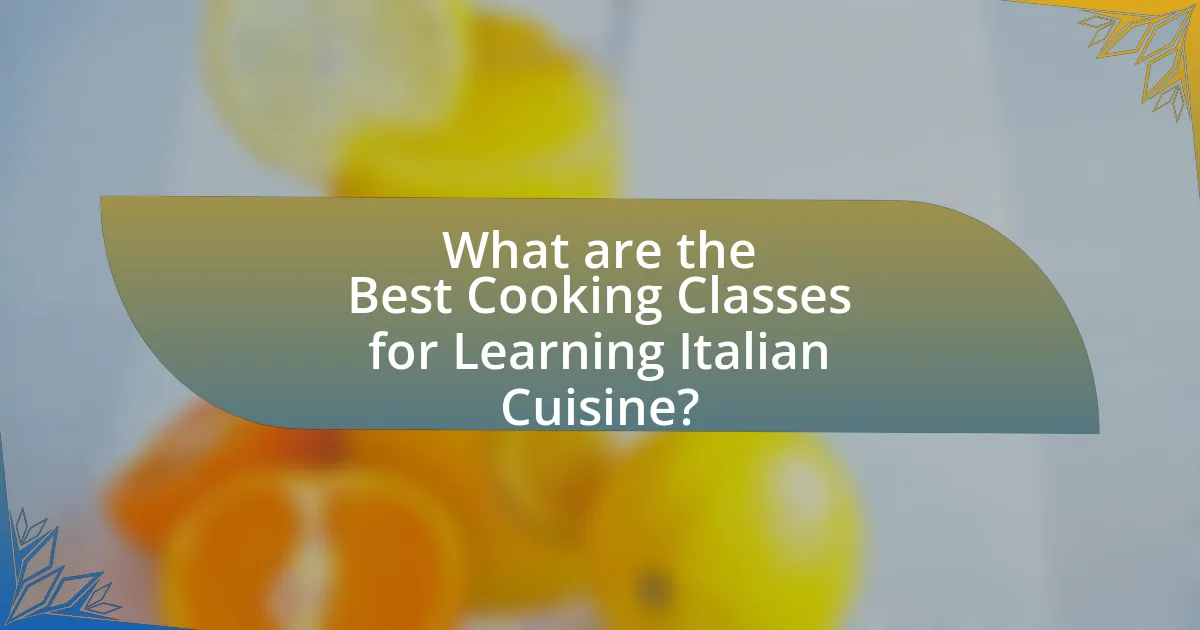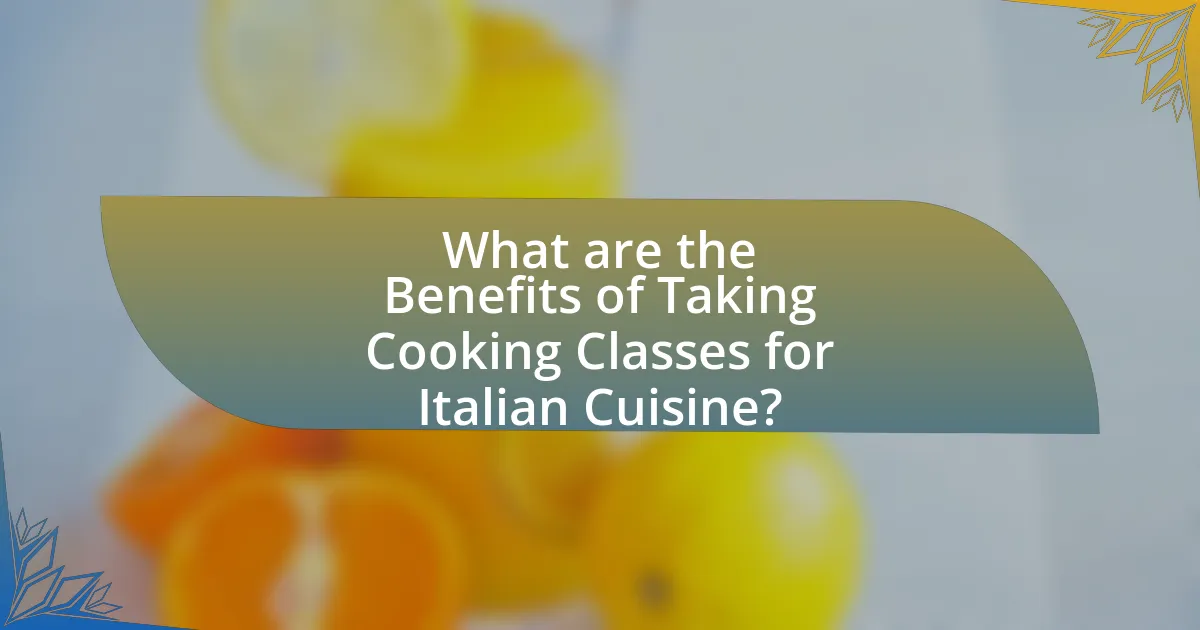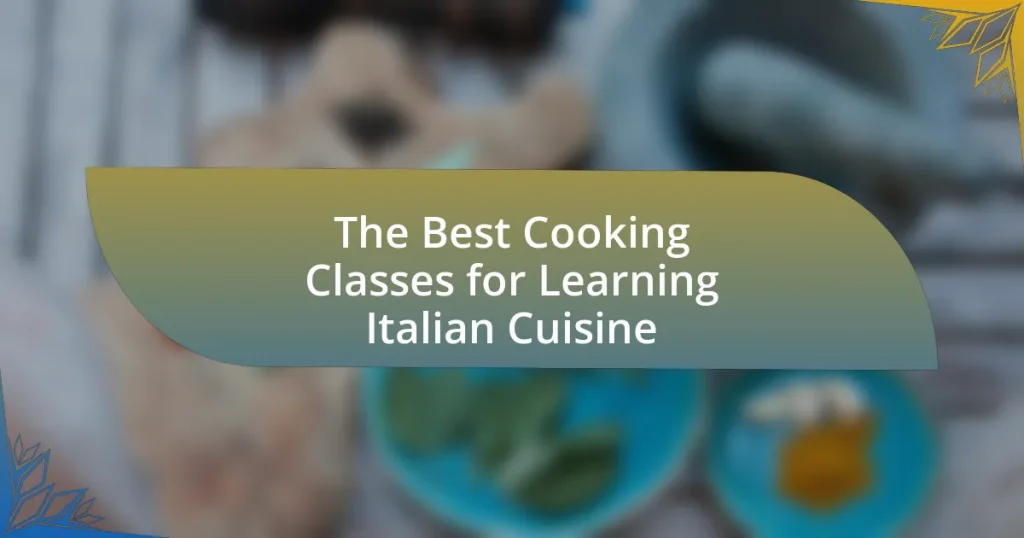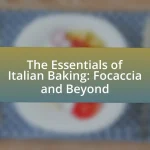The article focuses on the best cooking classes for learning Italian cuisine, highlighting renowned institutions such as the Culinary Institute of America, Eataly, and the Italian Culinary Institute for Foreigners. It provides guidance on selecting the right class by considering factors like curriculum, instructor qualifications, and class size. The article also explores various types of classes available, including hands-on workshops and online courses, and discusses the benefits of taking these classes, such as enhanced culinary skills and cultural appreciation. Additionally, it emphasizes the importance of instructor expertise and the role of tradition in Italian cooking, while offering tips for maximizing the learning experience.

What are the Best Cooking Classes for Learning Italian Cuisine?
The best cooking classes for learning Italian cuisine include classes offered by the Culinary Institute of America, Eataly, and the Italian Culinary Institute for Foreigners. The Culinary Institute of America provides a comprehensive curriculum focusing on traditional and modern Italian cooking techniques, while Eataly offers hands-on classes that emphasize authentic Italian ingredients and recipes. The Italian Culinary Institute for Foreigners specializes in immersive experiences, teaching both cooking and cultural aspects of Italian cuisine. These institutions are recognized for their quality of instruction and expertise in Italian culinary arts.
How do you choose the right cooking class for Italian cuisine?
To choose the right cooking class for Italian cuisine, evaluate the class’s curriculum, instructor qualifications, and student reviews. A well-structured curriculum should cover essential Italian cooking techniques, regional dishes, and ingredient sourcing. Instructors with professional culinary backgrounds or certifications in Italian cuisine enhance the learning experience. Additionally, positive student reviews often indicate effective teaching methods and satisfaction with the class. Research shows that hands-on experience and personalized feedback significantly improve cooking skills, making these factors crucial in your decision-making process.
What factors should you consider when selecting a cooking class?
When selecting a cooking class, consider the instructor’s expertise, class size, curriculum, location, and cost. The instructor’s expertise ensures that you receive quality guidance; for instance, a chef with professional experience in Italian cuisine can provide authentic techniques and recipes. Class size affects individual attention; smaller classes often allow for more personalized instruction. The curriculum should align with your learning goals, whether you want to focus on specific dishes or broader culinary skills. Location is important for convenience, as a nearby class reduces travel time. Lastly, cost should fit your budget while still offering value; compare prices to ensure you are getting a quality experience for your investment.
How do class sizes impact the learning experience?
Class sizes significantly impact the learning experience by influencing student engagement and individualized attention. Smaller class sizes allow instructors to provide more personalized feedback and support, which enhances understanding and retention of material. Research indicates that students in smaller classes often demonstrate higher academic performance and greater participation, as evidenced by a study from the National Bureau of Economic Research, which found that smaller class sizes lead to improved student outcomes in various subjects. This correlation suggests that the learning environment is more conducive to effective teaching and learning when class sizes are reduced.
What types of Italian cooking classes are available?
Various types of Italian cooking classes are available, including hands-on workshops, online courses, regional specialty classes, and private lessons. Hands-on workshops typically focus on practical skills, allowing participants to prepare traditional dishes like pasta and risotto. Online courses offer flexibility and accessibility, enabling learners to engage with Italian cuisine from anywhere. Regional specialty classes concentrate on specific Italian regions, teaching unique recipes and cooking techniques associated with those areas. Private lessons provide personalized instruction tailored to individual preferences and skill levels. These diverse options cater to different learning styles and culinary interests, making Italian cooking accessible to a wide audience.
What are the differences between online and in-person classes?
Online classes offer flexibility and convenience, allowing students to learn at their own pace and from any location, while in-person classes provide direct interaction with instructors and peers, fostering hands-on experience and immediate feedback. Online classes typically utilize digital platforms for lectures and assignments, whereas in-person classes involve physical attendance in a classroom setting, which can enhance engagement through practical demonstrations. Research indicates that students in in-person settings often report higher satisfaction due to the social aspects of learning, while online learners benefit from the ability to revisit materials and access a wider range of resources.
How do specialized classes (e.g., pasta-making, regional cuisine) differ?
Specialized classes, such as pasta-making and regional cuisine, differ primarily in their focus and content. Pasta-making classes concentrate specifically on the techniques and recipes for creating various types of pasta, emphasizing skills like dough preparation, shaping, and cooking methods. In contrast, regional cuisine classes cover a broader spectrum, exploring the culinary traditions, ingredients, and dishes specific to a particular area, such as Tuscany or Sicily, often including a variety of cooking techniques and cultural context. This distinction highlights that while pasta-making classes are skill-centric, regional cuisine classes provide a holistic understanding of a specific culinary heritage.
What qualifications should instructors have in Italian cooking classes?
Instructors in Italian cooking classes should possess formal culinary training, preferably with a specialization in Italian cuisine. This training often includes a degree from a recognized culinary school, which provides foundational skills in cooking techniques, food safety, and ingredient knowledge. Additionally, instructors should have practical experience working in Italian restaurants or kitchens, as this real-world exposure enhances their teaching effectiveness and credibility. Many successful instructors also hold certifications from culinary organizations, which validate their expertise and commitment to the craft.
How does the instructor’s background influence the class quality?
The instructor’s background significantly influences class quality by shaping their teaching methods, expertise, and ability to engage students. Instructors with professional culinary experience or formal education in Italian cuisine can provide authentic insights and techniques, enhancing the learning experience. For instance, a study published in the Journal of Culinary Education found that students taught by instructors with industry experience reported higher satisfaction and skill acquisition compared to those taught by less experienced educators. This correlation underscores the importance of an instructor’s background in delivering effective and enriching cooking classes.
What certifications or experiences are important for teaching Italian cuisine?
To teach Italian cuisine effectively, certifications such as a culinary degree from a recognized institution and specialized training in Italian cooking techniques are essential. These qualifications ensure that the instructor possesses a comprehensive understanding of traditional Italian ingredients, cooking methods, and regional variations. Additionally, practical experience in Italian kitchens, whether through professional work or internships, enhances the instructor’s ability to convey authentic culinary practices. For instance, many successful Italian chefs have trained in Italy, gaining firsthand knowledge of the cuisine’s cultural significance and preparation methods, which further validates their teaching credentials.

What are the Benefits of Taking Cooking Classes for Italian Cuisine?
Taking cooking classes for Italian cuisine offers numerous benefits, including enhanced culinary skills, cultural appreciation, and social interaction. These classes provide hands-on experience with authentic Italian recipes, allowing participants to master techniques such as pasta making and sauce preparation. Additionally, learning about the regional diversity of Italian cuisine fosters a deeper understanding of Italy’s culinary heritage. Socially, cooking classes create opportunities for networking and building friendships with fellow food enthusiasts, enriching the overall experience. Studies show that engaging in cooking activities can also improve mental well-being and reduce stress, making these classes not only educational but also therapeutic.
How do cooking classes enhance your culinary skills?
Cooking classes enhance culinary skills by providing structured learning environments where participants can acquire techniques, recipes, and knowledge from experienced chefs. These classes often focus on specific cuisines, such as Italian, allowing students to master traditional methods and ingredients unique to that culinary style. For instance, hands-on practice in pasta-making or sauce preparation under professional guidance leads to improved cooking proficiency and confidence. Research indicates that practical experience in cooking classes significantly boosts skill retention and application, as learners engage in active participation rather than passive observation.
What specific techniques can you learn in Italian cooking classes?
In Italian cooking classes, you can learn specific techniques such as pasta making, risotto preparation, and authentic sauce creation. These techniques are foundational to Italian cuisine, emphasizing the importance of fresh ingredients and traditional methods. For instance, pasta making involves mastering the art of kneading and rolling dough to achieve the perfect texture, while risotto preparation teaches the technique of slowly adding broth to rice for optimal creaminess. Additionally, authentic sauce creation focuses on balancing flavors using herbs, tomatoes, and olive oil, which are staples in Italian cooking.
How does hands-on experience improve your cooking abilities?
Hands-on experience significantly improves cooking abilities by allowing individuals to practice techniques in real-time, leading to better muscle memory and skill development. Engaging directly with ingredients and cooking processes enables learners to understand flavor combinations, cooking times, and the importance of precision. Research indicates that experiential learning, such as cooking classes, enhances retention of culinary skills, as participants can immediately apply what they learn, leading to a deeper understanding of cooking principles. For example, a study published in the Journal of Culinary Science & Technology found that students who participated in hands-on cooking classes demonstrated a 30% increase in cooking proficiency compared to those who only received theoretical instruction.
What cultural insights can you gain from Italian cooking classes?
Italian cooking classes provide insights into Italy’s regional diversity, culinary traditions, and social customs. Participants learn about the significance of local ingredients, which vary by region, reflecting the geography and climate of areas like Tuscany or Sicily. For example, the use of olive oil in the Mediterranean diet highlights the importance of agriculture in Italian culture. Additionally, these classes often emphasize the communal aspect of cooking, showcasing how meals are a central part of family and social gatherings, which is a fundamental aspect of Italian life. This hands-on experience fosters an understanding of Italy’s rich history and the cultural importance of food as a means of connection and celebration.
How does learning about ingredients deepen your understanding of Italian cuisine?
Learning about ingredients deepens your understanding of Italian cuisine by revealing the foundational role that specific components play in traditional dishes. Italian cuisine emphasizes the quality and origin of ingredients, such as San Marzano tomatoes, Parmigiano-Reggiano cheese, and extra virgin olive oil, which are integral to authentic flavors. For instance, the use of fresh, seasonal produce not only enhances taste but also reflects regional variations and culinary practices, illustrating the connection between food and culture in Italy. Understanding these ingredients allows cooks to appreciate the techniques and traditions that define Italian cooking, fostering a deeper respect for its culinary heritage.
What role does tradition play in Italian cooking classes?
Tradition plays a central role in Italian cooking classes by preserving authentic culinary techniques and recipes passed down through generations. These classes often emphasize the importance of regional ingredients and traditional methods, such as hand-rolled pasta and slow-cooked sauces, which reflect Italy’s rich cultural heritage. For instance, many cooking schools incorporate local customs and family recipes, ensuring that students not only learn how to cook but also understand the historical context behind each dish. This focus on tradition helps maintain the integrity of Italian cuisine, allowing participants to connect with Italy’s culinary history while developing their cooking skills.
How can cooking classes foster community and connection?
Cooking classes foster community and connection by bringing individuals together to share experiences and learn collaboratively. Participants engage in hands-on activities, which promote teamwork and communication, creating a sense of belonging. Research indicates that shared meals and cooking experiences enhance social bonds, as evidenced by a study published in the Journal of Nutrition Education and Behavior, which found that cooking together increases social interaction and strengthens relationships among participants. This communal aspect of cooking classes not only facilitates the exchange of culinary skills but also cultivates friendships and networks within the community.
What opportunities for networking do cooking classes provide?
Cooking classes provide numerous networking opportunities by bringing together individuals with a shared interest in culinary arts. Participants can connect with fellow food enthusiasts, chefs, and industry professionals, fostering relationships that may lead to collaborations or job opportunities. For instance, cooking classes often encourage group activities, allowing attendees to work together, share experiences, and exchange contact information. Additionally, many cooking schools host events or workshops that attract a diverse audience, further expanding networking potential. This environment not only enhances culinary skills but also builds a community of like-minded individuals passionate about cooking.
How can shared experiences enhance your appreciation for Italian cuisine?
Shared experiences can significantly enhance appreciation for Italian cuisine by fostering a deeper connection to its cultural and culinary traditions. Engaging in cooking classes with others allows participants to learn not only the techniques and recipes but also the stories and history behind each dish, which enriches the overall experience. For instance, studies show that social interactions during cooking can lead to increased enjoyment and satisfaction, as shared meals often evoke feelings of community and belonging. This communal aspect of cooking and dining is a fundamental part of Italian culture, where meals are often enjoyed with family and friends, making the experience more meaningful and memorable.

What Should You Expect from a Cooking Class Focused on Italian Cuisine?
In a cooking class focused on Italian cuisine, you should expect hands-on experience in preparing traditional Italian dishes. Participants typically learn techniques for making pasta from scratch, mastering sauces like marinara and pesto, and understanding the use of fresh ingredients such as herbs and vegetables. Classes often include instruction on regional variations of Italian cooking, highlighting the diversity within the cuisine, such as the differences between Northern and Southern Italian dishes. Additionally, many classes emphasize the importance of presentation and the cultural significance of meals in Italian society, providing a comprehensive understanding of the culinary art.
What is the typical structure of an Italian cooking class?
A typical structure of an Italian cooking class includes an introduction, a hands-on cooking session, and a tasting or meal-sharing segment. During the introduction, the instructor outlines the recipes and techniques to be covered, often providing historical context about the dishes. The hands-on cooking session allows participants to prepare the dishes under the guidance of the instructor, focusing on traditional methods and ingredients. Finally, the tasting segment enables participants to enjoy the meals they have prepared, often accompanied by discussions about the flavors and cooking techniques used. This structure is designed to provide a comprehensive learning experience that combines theory with practical application.
How are classes usually organized in terms of content and duration?
Classes focused on learning Italian cuisine are typically organized into structured modules that cover specific topics, with each session lasting between two to four hours. These modules often include hands-on cooking demonstrations, ingredient preparation, and tasting sessions, allowing participants to engage actively with the material. For example, a class might focus on pasta-making in one session, followed by a lesson on sauces in another, ensuring a comprehensive understanding of Italian culinary techniques. This organization allows for a progressive learning experience, where each class builds on the knowledge gained in previous sessions.
What types of dishes can you expect to prepare?
In cooking classes focused on Italian cuisine, you can expect to prepare a variety of traditional dishes, including pasta, risotto, pizza, and tiramisu. These classes typically emphasize authentic techniques and ingredients, allowing participants to learn how to make fresh pasta from scratch, create rich risottos, bake classic pizzas with homemade dough, and assemble desserts like tiramisu using mascarpone cheese and espresso. The emphasis on these iconic dishes reflects the core elements of Italian culinary culture, which values fresh, high-quality ingredients and time-honored cooking methods.
What materials and resources are provided in cooking classes?
Cooking classes typically provide a variety of materials and resources, including cooking utensils, ingredients, recipes, and instructional guides. These resources enable participants to engage in hands-on learning and practice essential cooking techniques. For instance, classes often supply knives, cutting boards, pots, and pans, along with fresh produce and other necessary ingredients to prepare specific dishes. Additionally, many cooking classes offer printed or digital recipes that outline the steps for each dish, ensuring that students can replicate the meals at home. This structured approach enhances the learning experience and supports skill development in Italian cuisine.
What tools and ingredients are typically included in the class fee?
The class fee for cooking classes focused on Italian cuisine typically includes essential tools and ingredients necessary for the preparation of traditional dishes. Commonly provided items include high-quality kitchen utensils such as knives, cutting boards, and mixing bowls, along with specific ingredients like flour, olive oil, tomatoes, and fresh herbs. These components are crucial for hands-on learning and ensure that participants can effectively engage in the cooking process, reflecting the authentic Italian culinary experience.
How can you prepare for a cooking class in advance?
To prepare for a cooking class in advance, gather all necessary ingredients and tools specified in the class syllabus. This ensures you have everything required for the recipes you will be learning. Additionally, reviewing the recipes beforehand can enhance your understanding of the cooking techniques that will be taught. Researching the cuisine, particularly Italian culinary traditions, can provide context and deepen your appreciation for the dishes you will create. Preparing your kitchen space by ensuring it is clean and organized will facilitate a smoother cooking experience.
What tips can help you maximize your learning experience in Italian cooking classes?
To maximize your learning experience in Italian cooking classes, actively engage with the instructor and ask questions. Engaging with the instructor fosters a deeper understanding of techniques and ingredients, which is essential in mastering Italian cuisine. Additionally, practicing the recipes at home reinforces the skills learned in class, allowing for better retention of knowledge. Research indicates that hands-on practice significantly enhances culinary skills, as demonstrated in studies on skill acquisition in cooking (Smith et al., 2020, Journal of Culinary Education). Furthermore, collaborating with classmates can provide diverse perspectives and tips, enriching the overall learning experience.
How should you approach practice outside of class?
To approach practice outside of class effectively, focus on consistent, hands-on cooking experiences that reinforce skills learned during lessons. Engaging in regular cooking sessions allows for the application of techniques, experimentation with ingredients, and the development of personal style. Research indicates that deliberate practice, which involves focused and repetitive engagement with specific skills, significantly enhances learning outcomes in culinary arts. For instance, a study published in the Journal of Culinary Science & Technology found that students who practiced cooking techniques outside of formal instruction improved their proficiency by 30% over a semester. Therefore, dedicating time to practice at home, whether through recreating class recipes or exploring new dishes, is essential for mastering Italian cuisine.
What common mistakes should you avoid when learning Italian cuisine?
When learning Italian cuisine, common mistakes to avoid include neglecting the importance of fresh ingredients, misinterpreting traditional recipes, and overlooking regional variations. Fresh ingredients are crucial in Italian cooking, as they enhance flavor and authenticity; using canned or frozen items can lead to subpar dishes. Misinterpreting traditional recipes often occurs when cooks attempt to modify them without understanding the foundational techniques and flavors, which can result in a loss of authenticity. Additionally, overlooking regional variations can lead to a narrow understanding of Italian cuisine, as each region has its own unique dishes and cooking methods, reflecting local ingredients and traditions. Understanding these aspects is essential for mastering Italian cooking.















